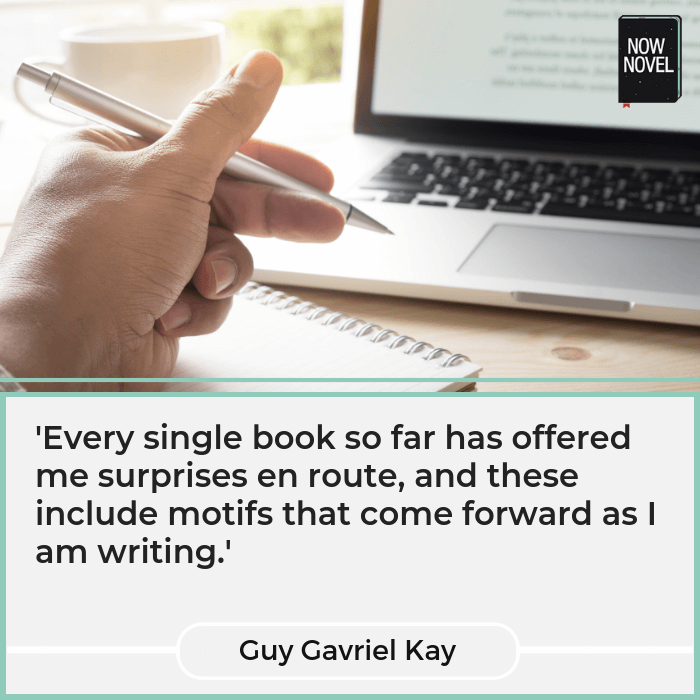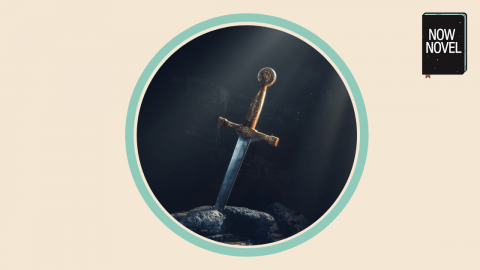The word ‘motif’ is often used interchangeably with the word ‘theme’ in writing about stories. What exactly are motifs in stories, and how can you use them effectively? Read a definition followed by tips to use them imaginatively:
What is a motif? Motif vs theme
Oxford dictionaries define motif as:
A dominant or recurring idea in an artistic work.
Oxford Dictionaries Online, ‘Motif’
The word is also used in other forms of art. For example, the three short notes followed by a long note in a descending minor third that open Ludwig van Beethoven’s famous Symphony no. 5 are a motif that some say symbolizes ‘fate knocking at the door’.
Like Beethoven developing his four opening notes, a writer can take a motif’s first image, phrase or idea and repeat and develop it in various ways. Although a motif is similar to a theme, there are some differences:
Motif vs theme: What’s the difference?
In The Cambridge Introduction to Narrative, H. Porter Abbott describes the relationship between motifs and themes thus:
‘Themes and motifs are the two terms most frequently used for the repetitions in narrative. As technical terms, they are often used interchangeably [… but] a theme is abstract and a motif is concrete. Beauty, nature, violence and love can be themes; roses, gardens, fists, and the phrase “Barkis is willin’ ” can be motifs. Themes are implicit in motifs, but not the other way around.’
Porter Abbot, The Cambridge Introduction to Narrative, ‘Interpreting Narrative’, p. 95
To summarize, a motif is:
- A concrete word, image, idea or phrase that’s repeated throughout a story (Porter Abbot gives the example of ‘widows’ in Wuthering Heights by Emily Brontë)
- Different to abstract themes like ‘honour’, ‘pride’ and ‘beauty’ in that it is the smaller, concrete element that contributes to our perception of themes (e.g. recurring widowed characters – a ‘widow motif’ – may draw our attention to themes of death, mourning or traditional gender roles)
- Something that recurs throughout a narrative, creating a sense of relationship between disparate events or character arcs
So how can you use motifs in interesting ways in stories?
1. Find motifs that connect your story’s separate threads
Many authors have used motifs to explore and develop story themes. For example, in Arthurian legends about the quest for the ‘Holy Grail’. In these legends, the motif of the ‘riddle’ (a puzzling question that creates a test of wisdom or character) crops up many times.
Riddles fool or trick some knights, while others are wiser in interpreting. The motif of the riddle is one element that unites their separate stories around the shared quest.
Look at the events of your story and think about what actions or emblems you could repeat in different characters’ arcs to create a sense of connection between them.
Example of a recurring motif phrase
A phrase can be a motif connecting different events in a narrative. For example, Vonnegut in his famous novel Slaughterhouse-Five repeats the motif phrase ‘so it goes’ after every death in the book.
This in effect makes each death in the story feel equivalent in some way, no more important than any other. It also creates the sense that death is unavoidable, coming to high and low places and people – regardless of their surface differences – alike.

2. Use motifs for descriptive unity
In James Joyce’s famous modernist novel, Portrait of the Artist as a Young Man, the protagonist Stephen describes the sounds of a game of cricket more than once:
”…the sound of the cricket bats: pick, pack, pock, puck: like drops of water in a fountain falling softly in the brimming bowl.’
James Joyce, A Portrait of the Artist as a Young Man, p. 63
This recurring description shows the development of Stephen’s artistic imagination, as he finds ways to describe the world around him using poetic language.
Recurring motifs in description provide many effects. They may:
- Symbolize themes important to the story (for example, a description of a family of animals observed in a park might draw our attention to the theme of ‘family ties’ in a story)
- Create a cohesive tone and mood (for example, a novel filled with motifs of dark, candlelit rooms and shadowy figures may create a Gothic, gloomy tone and mood)
3. Use motifs to foreshadow events
Recurring symbolic images or phrases are useful for creating foreshadowing (a hint in narrative of things to come).
Example of using motifs to foreshadow
In an episode of the sci-fi TV series Black Mirror, near the beginning of the episode we see characters in a video game arcade. In the game intro flashing on a screen, a car crashes off the road into a building.
Later in the episode, we learn that one of the main characters was once in a near-fatal car accident and is living on life support in virtual reality. The early visual introduces the ‘accident’ motif in the story. It introduces the related themes of the unpredictability and fragility of life, and the various ways technology is used to delay or avoid ‘game over’.
When you use a motif to foreshadow events:
- Find a concrete image that clearly relates to a later development (in the example above, we can easily recognize parallels between the virtual and ‘real world’ accidents)
- Vary motifs’ repetition: The first accident in the example is virtual, on a screen. The second is real, throwing a character into a perpetual virtual life (a cycle of immortal death and rebirth in a simulated reality). These two appearances of the ‘accident’ motif are varied enough to be interesting but also relate to each other

4. Draw on your central idea for motif ideas
Where can you find ideas for motifs your story could develop? A simple place to look is your central idea – the concise summary that gives the founding scenario for your story. [You can brainstorm your Central Idea at the start of our story outlining tool.]
For example, consider this summary of a Pulitzer-winning bestseller that could be the story’s central idea:
‘The lives of a blind French girl and a gadget-obsessed German boy before and during World War II.’
Blurb describing Anthony Doerr’s novel All the Light we Cannot See
Immediately we could think of possible motifs:
- Motifs having to do with vision (relating to the theme of blindness) – e.g. prescription glasses, blindfolds, closed eyes, hide and seek
- Motifs having to do with war (e.g. military drills, news broadcasts, marches, rallies, political arguments, etc.)
Each of these images itself could provide creative fodder for interesting scenes – a scene where a man drops his glasses fleeing cruel military men, for example. Look at your central idea and ask ‘what repeated images or motifs can I mine this idea for? How can I repeat and develop them in different, interesting, varied ways?
Motifs are just one example of literary devices that you can use. Read our list of other devices, too.
Join Now Novel to get help developing your story’s themes and motifs.

